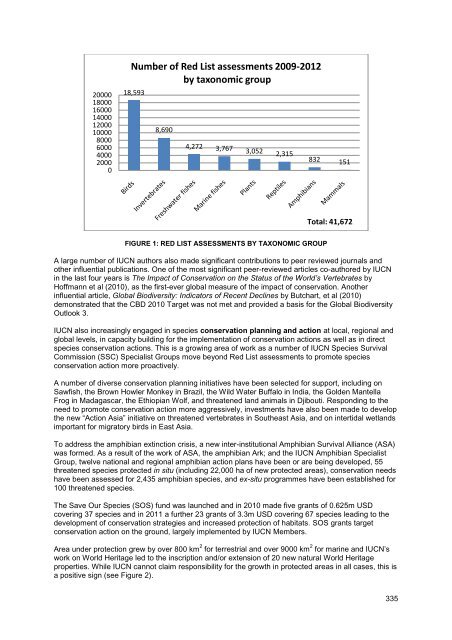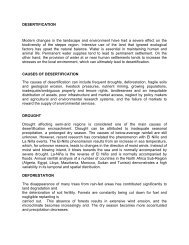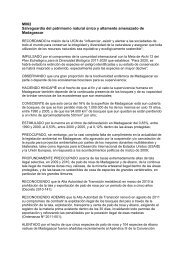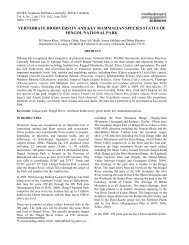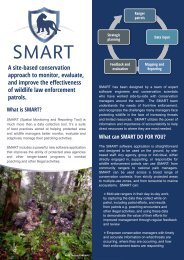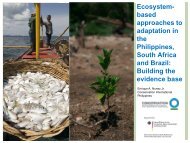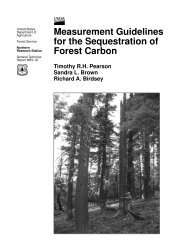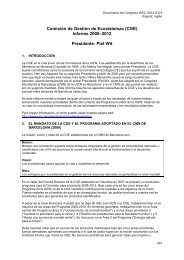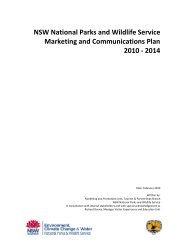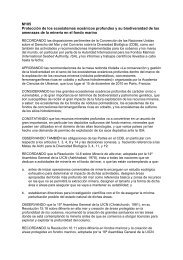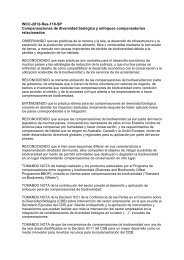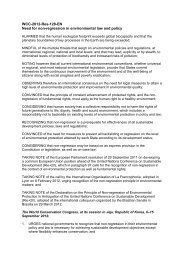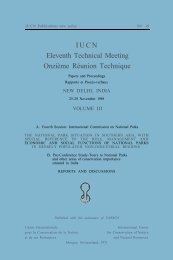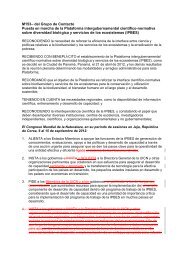Create successful ePaper yourself
Turn your PDF publications into a flip-book with our unique Google optimized e-Paper software.
20000180001600014000120001000080006000400020000Number of Red List assessments 2009-2012by taxonomic group18,5938,6904,272 3,767 3,052 2,315832 151Total: 41,672FIGURE 1: RED LIST ASSESSMENTS BY TAXONOMIC GROUPA <strong>la</strong>rge number of <strong>IUCN</strong> authors also ma<strong>de</strong> significant contributions to peer reviewed journals andother influential publications. One of the most significant peer-reviewed articles co-authored by <strong>IUCN</strong>in the <strong>la</strong>st four years is The Impact of Conservation on the Status of the World’s Vertebrates byHoffmann et al (2010), as the first-ever global measure of the impact of conservation. Anotherinfluential article, Global Biodiversity: Indicators of Recent Declines by Butchart, et al (2010)<strong>de</strong>monstrated that the CBD 2010 Target was not met and provi<strong>de</strong>d a basis for the Global BiodiversityOutlook 3.<strong>IUCN</strong> also increasingly engaged in species conservation p<strong>la</strong>nning and action at local, regional andglobal levels, in capacity building for the implementation of conservation actions as well as in directspecies conservation actions. This is a growing area of work as a number of <strong>IUCN</strong> Species SurvivalCommission (SSC) Specialist Groups move beyond Red List assessments to promote speciesconservation action more proactively.A number of diverse conservation p<strong>la</strong>nning initiatives have been selected for support, including onSawfish, the Brown Howler Monkey in Brazil, the Wild Water Buffalo in India, the Gol<strong>de</strong>n Mantel<strong>la</strong>Frog in Madagascar, the Ethiopian Wolf, and threatened <strong>la</strong>nd animals in Djibouti. Responding to theneed to promote conservation action more aggressively, investments have also been ma<strong>de</strong> to <strong>de</strong>velopthe new “Action Asia” initiative on threatened vertebrates in Southeast Asia, and on intertidal wet<strong>la</strong>ndsimportant for migratory birds in East Asia.To address the amphibian extinction crisis, a new inter-institutional Amphibian Survival Alliance (ASA)was formed. As a result of the work of ASA, the amphibian Ark; and the <strong>IUCN</strong> Amphibian SpecialistGroup, twelve national and regional amphibian action p<strong>la</strong>ns have been or are being <strong>de</strong>veloped, 55threatened species protected in situ (including 22,000 ha of new protected areas), conservation needshave been assessed for 2,435 amphibian species, and ex-situ programmes have been established for100 threatened species.The Save Our Species (SOS) fund was <strong>la</strong>unched and in 2010 ma<strong>de</strong> five grants of 0.625m USDcovering 37 species and in 2011 a further 23 grants of 3.3m USD covering 67 species leading to the<strong>de</strong>velopment of conservation strategies and increased protection of habitats. SOS grants targetconservation action on the ground, <strong>la</strong>rgely implemented by <strong>IUCN</strong> Members.Area un<strong>de</strong>r protection grew by over 800 km 2 for terrestrial and over 9000 km 2 for marine and <strong>IUCN</strong>’swork on World Heritage led to the inscription and/or extension of 20 new natural World Heritageproperties. While <strong>IUCN</strong> cannot c<strong>la</strong>im responsibility for the growth in protected areas in all cases, this isa positive sign (see Figure 2).335


